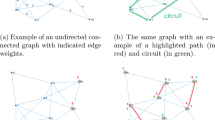Abstract
The longest cycle problem (LCP) has a crucial significance in graph theory and has a wide range of applications in the real-world. Although some excellent LCP solvers have been proposed in recent years, there is still a need for more efficient algorithms to solve the LCP of large-scale real-world complex networks. This paper proposed a fast algorithm ANTH-PDLS (ant heuristic with path disturbance local search) for the LCP. In ANTH-PDLS, two reduction strategies are proposed to reduce the scale of the networks, and a path disturbance strategy is proposed to expand the search ability. Experiments with randomly generated instances and real-world instances show that these strategies are effective. The average solution time of ANTH-PDLS on 21 real-world instances is only 15.5% of the existing excellent algorithms.









Similar content being viewed by others
References
Diestel R (2005) Graph Theory (Graduate Texts in Mathematics). Heidelberg, Springer, Berlin
Garey MR (1979) Computers and intractability: a guide to the theory of np-completeness. Revista Da Escola De Enfermagem Da USP 44(2):340
Mateti P, Deo N (1976) On algorithms for enumerating all circuits of a graph. SIAM J Comput 5(1):90–99
Tarjan R (1973) Enumeration of the elementary circuits of a directed graph. SIAM J Comput 2(3):211–216
Liu H, Wang J (2006) A new way to enumerate cycles in graph. Advanced Int’1 Conference on Telecommunications and Int’1 Conference on Internet and Web Applications and Services (AICT-ICIW’06). Guadeloupe, French Caribbean, pp 57–57
Jie W, Watts DJ (2002) Small worlds: the dynamics of networks between order and randomness. Acm Sigmod Record 31(4):74–75
Hawick K, James H, Scogings C (2007) Structural circuits and attractors in kauffman networks. Australian Conference on Artificial Life (ACAL’07). Gold Coast, Australia, pp 189–200
Dixon ET, Goodman Seymour E (1976) An algorithm for the longest cycle problem. Networks 6(2):139–149
Chalupa D, Balaghan P, Hawick KA, Gordon NA (2017) Computational methods for finding long simple cycles in complex networks. Knowl Based Syst 100(125):96–107
Chalupa D, Balaghan P, Hawick KA (2018) A probabilistic ant-based heuristic for the longest simple cycle problem in complex net- works. arXiv:1801.09227
Kumar P, Gupta N (2014) A heuristic algorithm for longest simple cycle problem. In: Proceedings of the International Conference on Wireless Networks (ICWN’14), Venice , Italy. pp 202-208
Sun Y, Cao Q, Wang B, Li S (2018) Sum rate maximization of d2d communications in cognitive radio network using cheating strategy. Wireless Communications & Mobile Computing, article ID 6065920. https://doi.org/10.1155/2018/6065920
Bodlaender HL (1993) On linear time minor tests with depth-first search. J Algorithms 14(1):1–23
Karger D, Motwani R, Ramkumar GDS (1997) On approximating the longest path in a graph. Algorithmica 18(1):82–98
Li MC (1995) Longest cycles in regular 2-connected claw-free graphs. Dis-crete Math 137(1–3):277–295
Paulusma D, Yoshimoto K (2008) Relative length of longest paths and longest cycles in triangle-free graphs. Discret Math 308(7):1222–1229
Feder T, Motwani R, Subi C (2002) Approximating the longest cycle problem in sparse graphs. SIAM J Comput 31(5):1596–1607
Chen G, Gao Z, Xingxing Y, Zang W (2005) Approximating the longest cycle problem on graphs with bounded degree. International Computing and Combinatorics Conference (COCOON’05). Kunming, China, pp 870–884
Sardroud AA, Bagheri A (2016) An approximation algorithm for the longest cycle problem in solid grid graphs. Discrete Appl Math 100(204):6–12
Takahara Y, Teramoto S, Uehara R (2008) Longest path problems on ptolemaic graphs. IEICE Trans Inf Syst 91(2):170–177
Shang J, Li P, Shi Y (2021) The longest cycle problem is polynomial on interval graphs. Theoret Comput Sci 859:37–47
Liu C, Li H, Leonce A, Burge L, Trimble J, Keiller P, Yakubu AA (2010) A Heuristic Algorithm for Finding the Longest Pathways in a Biochemical Network. The Ninth International Conference on Machine Learning and Applications. DC, USA, Washington, pp 515–522
Adriaens F, Aslay C, De Bie T, Gionis A, Lijffijt J (2019) Discovering interesting cycles in directed graphs. In: Proceedings of the 28th ACM International Conference on Information and Knowledge Management, NewYork, US, pp. 1191–1200
Becker MY, Rojas I (2001) A graph layout algorithm for drawing metabolic pathways. Bioinformatics 17(5):461–467
Ma X, Huang L, Lai YC, Zheng Z (2009) Emergence of loop structure in scale-free networks and dynamical consequences. Phys Rev E 79(5):056106
Tamassia R (2013) Handbook of graph drawing and visualization. CRC Press, Boca Raton, US
Chalupa D, Hawick KA (2019) Graphcombex: a software tool for exploration of combinatorial optimization properties of large graphs. Soft Computi 23(14):5715–5724
Minjing Y, Ye Z, Liu YJ, He Y, Wang CCL (2019) Lineup: computing chain-based physical transformation. ACM Trans Graph (TOG) 38(1):1–16
Zhang WQ, Liu YJ (2011) Approximating the longest paths in grid graphs. Theor Comput Sci 412(39):5340–5350
Rossi RA, Ahmed NK (2015) The Network Data Repository with Interactive Graph Analytics and Visualization. In: Proceedings of the Twenty-Ninth AAAI Conference on Artificial Intelligence AAAI Press, Texas, USA, pp.4292-4293
Bastian M, Heymann S, Jacomy M (2009) Gephi: an open source software for exploring and manipulating networks. International AAAI Conference on Weblogs and Social Media. California USA, San Jose, pp 361–362
Author information
Authors and Affiliations
Corresponding author
Additional information
Publisher's Note
Springer Nature remains neutral with regard to jurisdictional claims in published maps and institutional affiliations.
Rights and permissions
About this article
Cite this article
Guo, P., Jiang, Y. An improved ant-based heuristic approach for solving the longest cycle problem in large-scale complex networks. J Supercomput 78, 14164–14190 (2022). https://doi.org/10.1007/s11227-022-04409-3
Accepted:
Published:
Issue Date:
DOI: https://doi.org/10.1007/s11227-022-04409-3




